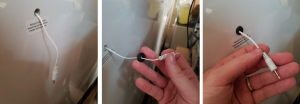Learn how to properly install a data logger through a probe access port on your refrigerator or freezer
With Coronavirus (COVID-19) vaccines now available, storing these vaccines at a stable continuous temperature in medical-grade refrigerators & freezers is vital. All vaccines should be stored at specific temperatures based on vaccine type. These temperatures include +4°C, -20°C and some at ultra-low temperatures (-70°C and colder). A purpose-built medical refrigerator or freezer is recommended to meet CDC guidelines. Along with a medical-grade refrigerator or freezer, you will also need a properly installed data logger and/or thermometer. These data monitoring devices track your units temperatures to make sure the appropriate temperatures are being used at all times.

Regardless if you are storing vaccines or sensitive research samples, installing your data logger/thermometer properly while not compromising the seals or stability of your unit is key. Improper installation is typically caused by users running data loggers or thermometers through the door gasket (as seen on the left). This compromises the stability of their laboratory and/or vaccine cold storage units. Doing this will allow excess air to enter the unit causing temperature fluctuations and it also forces the compressor to work even harder in order to try and keep the internal temperature at its set temperature. This kind of unnecessary strain on the compressor eventually leads to complete failure, potentially jeopardizing thousands of dollars’ worth of vaccines and research samples.
The CDC recommends installing all data loggers or thermometers by running the cords through the designated access ports on the vaccine units. Access ports can be found on all of LabRepCo brand Futura/Clinicool© as well as PHCbi refrigerators & freeezers. You can do this yourself, with no technical knowledge, and it’s easier than you might think.
Watch this short instructional video or read through the step by step instructions below:
Install a Data Logger Instructions:
What you need:
- Plumbers’ putty (available at most home improvement and DIY stores)
- A screwdriver, or similar tool
Instructions
1. Begin in front of the unit with the door open. Inside, on the rear wall, remove the white center caps and black O-ring gaskets from the inside of the unit, and then remove these from the outside of the unit (on the back). DON’T throw away the black O-ring gaskets because you will need these later on.

2. Using a screwdriver or similar tool force out the silicone caulking that is inside the probe port. When finished, you should be able to see clearly directly through the probe port.

3. Take your probe wire and thread it through the black O-ring gasket. Now thread the probe wire through the probe port and to the other side. Next install the black O-ring gasket back into position on the inside of the unit. This protects the wire from sharp edges.

4. Thread the probe wire through the second black O-ring gasket on the outside of the unit. Next, install that O-ring gasket back into position.

5. Using the plumbers’ putty seal both sides of the probe port, preventing airflow through the probe port.

6. Place your buffered probe into the most central part of the unit. If you purchased a freezer with evaporator coil shelves, then the probe will need to be isolated from the shelf in some way and not in direct contact with the shelf.

For more information or questions on data loggers or temperature monitoring, please contact us today to speak with your local LabRepCo sales representative. We hope this has been a helpful step-by-step installation tutorial properly using a temperature data monitoring device through a probe access port. For more information on our Medical and Laboratory Refrigerators and Freezers, please select from below or contact us today to speak with a cold storage specialist.




